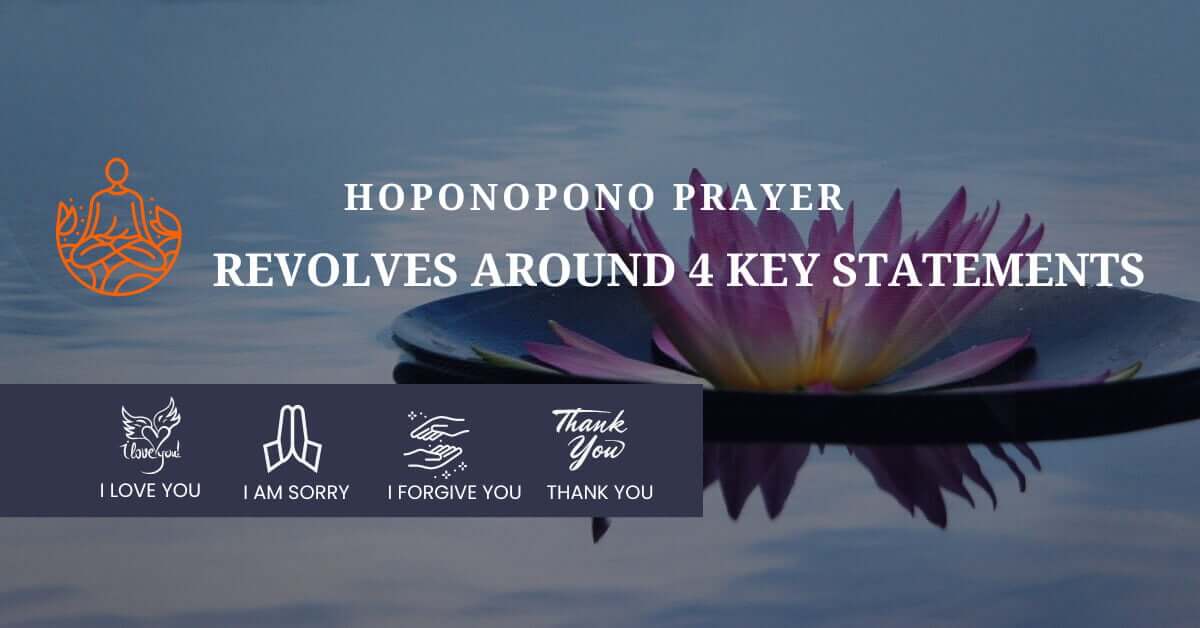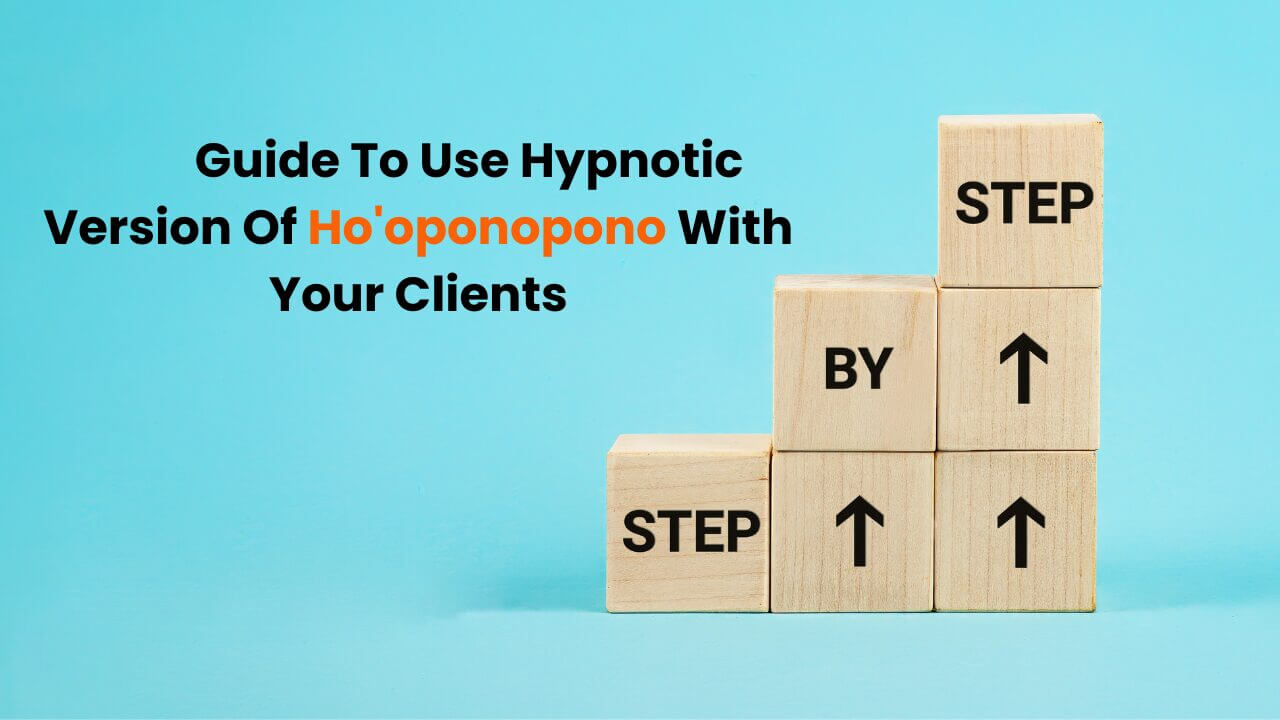Ho’oponopono Prayer
The Ho’oponopono Prayer Revolves Around Four Key Statements
- I Love You
- I am Sorry
- I Forgive You
- Thank You

Hypnotic Version of Ho’oponopono
The Hypnotic form of Ho’oponopono revolves around using guided imagery to help clients actually experience the essence of these statements
Therapeutic Process
- Help the client experience a deep hypnotic state and then imagine themselves on a beach.
- Using an analogy between the sea and the universal consciousness.
- Asking clients to write the message I Love You on the and with the same name of all the people that they would like to express their love for starting with their own name on top of the list.
- Next once the clients have written the names, suggest that the water from the sea comes and takes the name and the message with it back into the sea, and as the sea represents the universal consciousness, the message is delivered to all the people whose names were mentioned below the message. You can also add the client’s breath will become deeper once the message has been delivered.
- Ask the client to write the message I am Sorry on the sand and below the message names of all the people that they may have hurt knowingly or unknowingly, again starting with their own name first.
- Once again suggest that the water will deliver the message to all the people whose names are mentioned on the list.
- Ask the client to write the message I Forgive You on the sand and below the message names of all the people that may have hurt the client through their actions or inactions, again starting with their own name first.
- Once again suggest that the water will deliver the message to all the people whose names are mentioned on the list.
- Finally, ask the client to write the message Thank You and below that the names of all the people, starting with their own name, who has played any role in their lives as each of these people has helped the client become who he/she is today.
- Once again suggest that the water will deliver the message to all the people whose names are mentioned on the list.
While you are doing the process, you can make the experience more real and more powerful using additional Hypnotic suggestions. You can also ask the client to notice the lightness they experience with every name they write under each message. And, also make it a point to add a suggestion that after the Thank you message is delivered, the client receives an insight or a revelation that can transform the client’s life.
Once the client receives the insight you can even future pace the insight so that the client can experience how the application of this insight will change their life.
Once the client notices the application of the insight you can wake up the client from a Hypnotic State.
After the client wakes up, in most cases you would realize that the client’s expression itself tells you how powerful this experience was for the client. It is at that moment that you may also realize what a privilege it is to actually be in this profession. The fact you can notice the transformation in the client’s life is an experience that is difficult to describe.
If you would love to have these experiences and create powerful transformations in your clients’ lives, go ahead and apply these steps to your clients.
In case you are a practicing psychologist who understands the importance of training under supervision and guidance, which I highly suggest, do check out the Cognitive Hypnotic Psychotherapy Diploma. You will not just learn the Hypnotic version of Ho’oponopono and a lot more but also how to integrate multiple techniques seamlessly as a part of a comprehensive eclectic approach to therapy.
Why use I Forgive You Instead of Please Forgive Me in the Hypnotic Version Of Ho’oponopono?
I shared that I use ho’oponopono with clients who have suppressed multiple emotions, because of multiple people across multiple events.
Most of these clients feel that others or situations are responsible for their current challenges. So before I begin with any process, I use the FLIP model to help clients understand that irrespective of who they feel the source of the problem is, it is really about themselves and their abilities to find a way around the problem.
This also helps the client recognize that it is important for them to accept and forgive themselves. And it is with this understanding that we conduct the hypnotic version of ho’ponopono.
The client during the process is really expressing their Love to themselves, saying Sorry for things that they may have done or not done which have caused pain to themselves, Forgive themselves for those things, and finally Thank themselves for everything they have experienced.
Given that the client is doing this process with themselves, saying I Forgive you is more powerful than just seeking forgiveness, which is kind of already addressed in the previous statement when they say “I am Sorry” to themselves.
If Ho’oponopono is about self healing, why ask clients to write the names of other people?
Well, that is really a bonus as it allows us to save time by helping clients also address any residual emotions that they may be holding on to with respect to others. That said in most cases by the time the process is complete the client’s realization that it is more about themselves than about others is already stronger.
What other techniques can we integrate with Ho’oponopono during therapy?
There are many techniques that you can actually integrate within the hypnotic ho’oponopono framework. The techniques that I frequently integrate within this framework include inner child.
At the end of the thank you message, I will ask the client to invite all parts that were earlier holding on to the feeling of guilt or hurt or anger or any other similar feelings that they may have experienced in their life. After the client can notice these parts or inner children on the beach, I continue with the inner child integration.
If the client gets stuck at one of the messages where the water is not able to take the message and it still remains imprinted on the sand, then I would combine the N-step re-framing to address the positive intention behind holding on to the emotions.
Then there are times when I will first run a modified version of the NLP Levels of change on the beach, before continuing with the ho’oponopono.
Almost always I would add revelation metaphor and future pacing in the mix and anchor the good feelings they are experiencing before ending the process.
These are just some examples of integration because of the way I work with clients, I may also end up creating a new process together during or after the ho’oponopono process depending upon how the session is proceeding and what was the objective that I was looking at achieving through the sessions.
If you have any other questions about the process, do feel free to ask us in the comments.
Here, I have shared with you the step-by-step guide to using the Hypnotic version of Ho’oponopono that can be used to help clients along with the basis on which I select which techniques to use with which category of clients.
If you would like to learn these techniques and a lot more under supervision and guidance do check out the Cognitive Hypnotic Psychotherapy Diploma. If you are not aware of the different courses that we offer at ICHARS, here is a list of all the courses focusing on developing advanced coaching competencies and therapeutic skills.
If you need any help or have any questions do feel free to connect with our team @ +91-8080208473 or schedule an appointment with our lead trainer.

